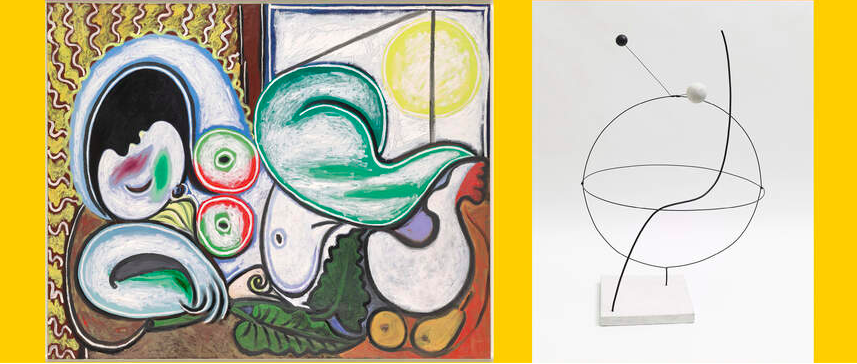
Today I went to see Calder/Picasso at the de Young. It was superb. The grandsons of the two artists came together and created this interesting dialogue between their art, paying special attention to the five or six junctions in the two artists’ lives in which they met (mostly in Paris.)
Beyond the obvious beauty and genius of the artifacts themselves, the exhibition in its entirety reminded me that very few of the things referred to as “curation” actually fit the bill; nowadays anyone who makes a list or puts together a gift basket or a playlist fancies themselves a “curator.” This exhibition was an excellent example of the careful act of knowledgeable selection, matching, and sequencing that rises to that level: the pairing of Calder’s mobiles and sculptures with Picasso’s paintings and sculptures was superb. One of my favorite rooms was dedicated to the circus, which figured greatly in the works of both artists in their early years. Calder’s acrobat wire sculptures and Picasso’s circus scenes maintain a marvelous dialogue. I also liked the associations the exhibition made between construction and deconstruction, and the discerning selection of works that exemplify this principle (for example, Picasso’s series of bulls and Calder’s larger mobiles.) Another association was exploring dimensions beyond the medium: Picasso exploring depth through his cubist work, for example, and Calder’s exploration of mobility and sound through his gongs.
Relatedly, I noticed that both artists had an early figurative phase (Picasso’s blue and pink periods, Calder’s acrobats) and, around the 1930s, started moving toward abstract work. I wonder if other artists of the period in Paris went through a similar transformation. It was certainly an issue of cultural inspiration–Calder went abstract after visiting Mondrian’s studio.
The larger scale sculptures reminded me of a wonderful exhibition I saw a few years ago in Bologna, titled Ex Africa. One of the most stunning rooms of the exhibition featured a terrific video matching surrealist works from the 1930s with traditional African art, showing how much the latter inspired the former (without attribution.) I wish this exhibit had examined more critically the issue of sources of inspiration, even as it paid well-deserved homage to the works themselves.
Finally, I was struck by the difference in the depiction of lovers and family members between the two artists. Picasso, as we all know, juggled many women, rendering them insecure and unstable, driving Dora Maar (and others) to the brink of suicide, and his works deconstructing his lovers are instructive. Calder, by contrast, seems to have been a one-woman man with a stable family life, and the exhibition features a lovely heart mobile made of sheet metal that he made for his wife. There’s a big difference between making art for your lover and making your lover into art. Appreciate both, marry the first kind.
Calder-Picasso shows at the de Young through May 23, 2021; order your tickets here.




No comment yet, add your voice below!